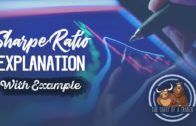Sharpe Ratio Definition & Example | How to Calculate Risk Adjusted Return
Do you want to know more about Sharp Ratio and how to calculate risk adjusted return? Watch our latest video for a clear sharpe ratio definition and useful examples.
Sharpe Ratio Definition & Example
The Sharpe Ratio that is referred to in the financial world is named after William F. Sharpe, a Nobel laureate in economics. It’s simply a measure of calculation for a risk-adjusted return and is the industry standard when it comes to doing such things. That’s the average return earned in excess of what is considered to be risk free assets. In general, this normally is suggested as US Treasury bills, which is considered to be “risk free.”
The Sharpe Ratio works as follows: the average rate of return for your portfolio is subtracted by the best available rate of return of a risk-free security. Then, you divide that number by a standard deviation of the portfolio’s return. Essentially, a return of “zero” is the same as a treasury bill. A number of 1.0 or above is attractive, a return of 2.0 is even better, and one of 3.0 is excellent. These numbers are used to compare one portfolio to another, in order to see whether you are getting acceptable returns for holding risky assets over risk-free assets. Essentially, it’s a way to compare 2 portfolios in an even playing field.



 Difference Between Hammer and Hanging Man 2023 [ Must Watch for Trader ]
Difference Between Hammer and Hanging Man 2023 [ Must Watch for Trader ]